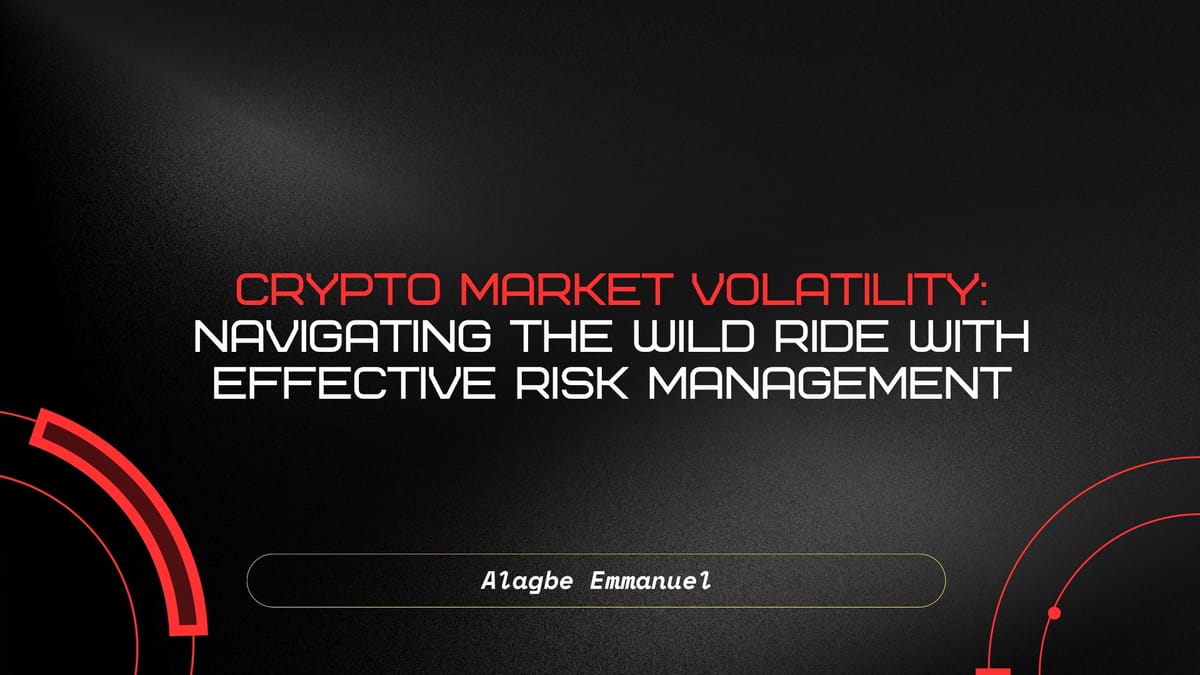Crypto Market Volatility: Navigating the Wild Ride with Effective Risk Management

Background: The Evolution of Crypto Volatility
The cryptocurrency market, born with Bitcoin’s launch in 2009, has always been a crucible of innovation and unpredictability. In its early days, Bitcoin’s price fluctuated wildly as it transitioned from a niche experiment to a global phenomenon. For instance, in 2011, Bitcoin pumped from $1 to $31 before crashing back to $2 within months. These dramatic swings set the tone for the crypto market’s reputation as a high-risk, high-reward arena.
As the market matured, the introduction of Ethereum in 2015 and the subsequent explosion of altcoins and initial coin offerings (ICOs) in 2017 amplified volatility. The 2017 bull run saw Bitcoin climb to nearly $20,000, only to plummet to $3,200 by late 2018. More recently, the 2021 bull market pushed Bitcoin to an all-time high of $69,000, followed by a brutal 2022 bear market that erased over 60% of its value. These cycles highlight a fundamental truth: volatility is woven into the fabric of cryptocurrencies.
Several structural and behavioral factors drive this volatility. Unlike traditional markets, crypto operates 24/7 across decentralized global exchanges, with no circuit breakers to halt trading during extreme swings. The market’s relative youth, speculative fervor, and sensitivity to external triggers, like regulatory news or influential posts on platforms like X, create an environment where prices can shift dramatically in hours. Yet, this volatility is also what draws traders and investors, offering unparalleled opportunities for profit alongside significant risks.
Today, as cryptocurrencies gain traction with institutional investors and mainstream adoption grows, understanding and managing volatility is more critical than ever. Whether you’re a seasoned trader or a newcomer, effective risk management strategies can mean the difference between thriving in this dynamic market and facing devastating losses. This article delves into the causes of crypto market volatility, its implications, and actionable strategies to navigate the wild ride with confidence.
Why Are Crypto Markets So Volatile?
Cryptocurrency markets are uniquely volatile due to a combination of structural, economic, and psychological factors:
- Market Immaturity and Low Liquidity: Despite its growth, the crypto market remains a fraction of the size of traditional financial markets. Many cryptocurrencies, especially smaller altcoins, suffer from low liquidity, meaning even modest buy or sell orders can cause outsized price movements. Thin order books exacerbate this, as seen when obscure tokens skyrocket or crash based on minimal trading activity.
- Speculative Trading: Much of crypto’s trading volume is driven by speculation rather than intrinsic value. Retail investors, often swayed by hype on platforms like X or Reddit, chase quick profits, fueling rapid price surges during bull runs and panic selling during downturns. This herd mentality amplifies volatility, as seen in the meteoric rise and fall of meme coins like Dogecoin.
News and Sentiment Sensitivity: Crypto prices are hypersensitive to news, from regulatory crackdowns to endorsements by high-profile figures. For example, a single post from a prominent influencer or a government’s announcement about crypto taxation can trigger market-wide rallies or sell-offs. The 24/7 nature of crypto trading means these reactions are swift and often exaggerated.
- Leverage and Margin Trading: Many crypto exchanges offer leverage as high as 100x, allowing traders to amplify their exposure. While this can lead to massive gains, it also increases the risk of liquidations during price drops, which can cascade into broader market declines. The 2021 crash, partly fueled by over-leveraged positions, underscored this danger.
- Lack of Intrinsic Value: Unlike stocks tied to company earnings or commodities with physical utility, many cryptocurrencies lack clear fundamentals. Their prices are often driven by sentiment, adoption trends, or speculative narratives, making them prone to wild swings. This is especially true for tokens with no real-world use case.
- Global and 24/7 Trading: Crypto markets never sleep, operating across decentralized exchanges worldwide. This constant trading, combined with diverse participants—from retail traders in Asia to hedge funds in the U.S.—means prices can shift dramatically at any moment in response to global events or coordinated trading.
- Technological and Security Risks: Hacks, protocol vulnerabilities, or network upgrades can significantly impact prices. For instance, a major exchange hack or a failed blockchain upgrade can erode investor confidence, triggering sell-offs. Conversely, successful developments, like Ethereum’s shift to proof-of-stake, can spark rallies.
The Implications of Volatility
Volatility shapes the crypto market’s allure and its challenges. For traders, it creates opportunities to profit from short-term price movements, as seen in the rapid gains of altcoins during bull runs. However, it also poses substantial risks. The 2022 bear market, for example, wiped out trillions in market capitalization, leaving many retail investors with significant losses.
Beyond financial risks, volatility hinders mainstream adoption. Businesses hesitate to accept cryptocurrencies as payment when their value can drop 10% overnight, and consumers are wary of using them as a store of value. This instability also attracts regulatory scrutiny, as governments seek to protect investors from the market’s wild swings.
Yet, volatility is a feature, not a bug, for many crypto enthusiasts. It reflects the market’s dynamism and potential for outsized returns. Bitcoin’s 200% rally in 2020 or Ethereum’s 400% surge in 2021 are testaments to this. The challenge is harnessing these opportunities while safeguarding against the inevitable downturns.
Risk Management Strategies for Crypto Investors
Navigating crypto’s volatility requires discipline, preparation, and a clear strategy. Here are ten practical risk management strategies to help investors and traders thrive in this unpredictable market:
1. Diversify Your Portfolio
Spreading your capital across multiple cryptocurrencies reduces the impact of a single asset’s price crash. For example, holding a mix of Bitcoin, Ethereum, and promising altcoins, alongside stablecoins like USDT or USDC, can balance risk and reward. Stablecoins, pegged to fiat currencies, provide a safe haven during market downturns.
2. Set Clear Investment Goals and Risk Tolerance
Define your objectives, long-term holding, short-term trading, or a hybrid approach, and assess your risk tolerance. Decide what percentage of your portfolio you’re willing to lose and stick to it. Clear goals prevent impulsive decisions driven by fear or greed, which are common during volatile periods.
3. Use Stop-Loss and Take-Profit Orders
Stop-loss orders automatically sell your assets at a predetermined price to limit losses, while take-profit orders lock in gains when prices hit a target. These tools are invaluable in crypto’s 24/7 market, where prices can plummet overnight. However, set stop-losses carefully to avoid being triggered by short-term dips.
4. Avoid Over-Leveraging
High leverage can lead to catastrophic losses, especially during volatile periods. For instance, a 5% price drop can wipe out a 20x leveraged position. If you use leverage, keep it conservative (e.g., 2x or 3x) and maintain sufficient margin to weather market swings.
5. Dollar-Cost Averaging (DCA)
DCA involves investing a fixed amount regularly, regardless of market conditions. This strategy reduces the risk of buying at a peak and lowers your average purchase price over time. For example, investing $100 monthly in Bitcoin during 2022’s bear market would have yielded better returns than a lump-sum investment at the 2021 peak.
6. Stay Informed and Avoid FOMO
Crypto markets are driven by sentiment, often amplified by posts on X or other platforms. Avoid chasing hype without research. Focus on a project’s fundamentals, its team, technology, and use case to make informed decisions. Subscribing to credible news sources and following reputable analysts can help you stay grounded.
7. Secure Your Assets
Volatility isn’t the only risk, security is paramount. Store your cryptocurrencies in a hardware wallet (e.g., Ledger or Trezor) or a secure software wallet, rather than on exchanges, which are prone to hacks. Enable two-factor authentication (2FA) and safeguard your private keys to protect against theft.
8. Manage Position Sizes
Limit each investment or trade to a small percentage of your portfolio (e.g., 1-5%). This ensures that even a total loss on one position won’t devastate your finances. Position sizing is critical when investing in high-risk altcoins, which can lose 90% or more during bear markets.
9. Monitor Market Sentiment and Technical Indicators
Tools like the Fear and Greed Index, moving averages, or relative strength index (RSI) can gauge market sentiment and identify potential entry or exit points. While technical analysis isn’t foolproof in crypto’s erratic market, it can provide valuable context for decision-making.
10. Plan for Taxes and Compliance
Price swings can trigger taxable events, especially for active traders. Keep detailed records of your transactions and consult a tax professional to ensure compliance with local regulations. In the U.S., for example, the IRS treats cryptocurrencies as property, subjecting gains to capital gains tax.
Conclusion
Crypto market volatility is both a challenge and an opportunity. While it fuels the potential for extraordinary returns, it demands discipline and strategic planning to avoid crippling losses. By diversifying your portfolio, setting clear goals, using tools like stop-loss orders, and prioritizing security, you can navigate the market’s wild swings with confidence. As the crypto market continues to evolve, those who master risk management will be best positioned to capitalize on its potential while weathering its storms.
Whether you’re a HODLer riding out the cycles or a trader chasing short-term gains, the key is to stay informed, stay disciplined, and never bet more than you can afford to lose. In the unpredictable world of crypto, preparation is your greatest asset.



Comments ()